Remembering the Legacy of the Chicago College All-Star Game
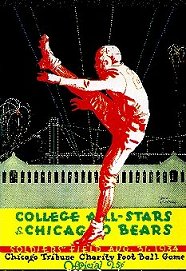
From the initial game in 1934 through 1976, the annual Chicago College All-Star Game was a fan favorite and provided a glimpse into the new talent of NFL stars.
Imagine a crowd of 105,840 people turning out to watch an NFL preseason game. Probably wouldn’t happen today unless it included a cage match between Michael Vick and Adam “Pacman” Jones. However, for more than 40 years the Annual Chicago College All-Star Game was a fan favorite while helping establish the NFL as a premier sports league.
In the 1930s, the NFL was still a fledgling league looking for a foothold in a sports world where baseball and boxing were the kings. In fact, professional football players were often seen as mercenaries while the college players were better known and more popular across the country.
A year after organizing the first Major League Baseball All-Star Game at Comiskey Park, Arch Ward, the sports editor for the Chicago Tribune, cultivated the idea of hosting an annual game between the defending NFL Champions and the best of the recently graduated college football stars.
The game was originally played in late August and then eventually moved earlier in the month and eventually into July as the NFL schedule was altered.
For the first game, held on August 31, 1934 at Soldier Field, Ward assembled a panel of 30 sports writers from across the country to choose the All-Stars. They then spent two weeks training in Chicago in preparation for a battle against the defending NFL Champion Chicago Bears.
The Bears were coming off an NFL Championship Game victory over New York Giants in 1933 and on their way to posting a perfect 13-0 regular season in 1934 before losing the title game to the New York Giants. The squad was dotted with Hall of Fame players including Bronko Nagurski, George Musso, Link Lyman, Bill Hewitt, Walt Kiesling and an aging Red Grange.
The College All-Stars were an eclectic group that included players from many of the traditional Northeast and Mid-West powers of the time including Pittsburgh, Notre Dame, Michigan, Ohio State, Iowa and Purdue along with players from other schools including Tennessee, Nebraska, Oregon State, Oregon, Washington and Southern California.
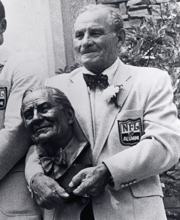
Future Hall of Fame coach Sid Gillman played in the first Chicago College All-Star Game.
Perhaps the most notable player from that game on the college team was future Hall of Fame coach Sid Gillman, who had played his collegiate football at Ohio State.
Gillman famously claimed that it was after being hit by Bronko Nagurski during the All-Star Game that he realized his best chance at NFL success was as a coach. Though an All-Big 10 end at Ohio State, Gillman never played in the NFL and his only action as a professional player came with the Cleveland Rams of the American Football League in 1936.
The captain of the college team was Ed Krause from Notre Dame. According to the game write-up, the top performers for the All-Stars included Joe Laws from Iowa, Mike Mikulak from Oregon and Herman Everhardus from Michigan.
Amazingly, the College All-Stars matched the best of the NFL play for play throughout the game. An interception by Law late in the contest thwarted the best scoring chance for the Bears and the game ended in a 0-0 tie.
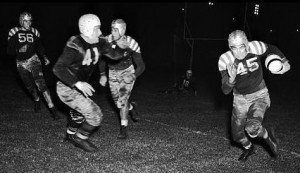
Sammy Baugh (#45) led the College All-Stars to their first victory in the series in 1937.
Over the remainder of the decade, as the college superstars continued to dominate the headlines and interest, future NFL greats including Sammy Baugh, Tuffy Leemans, Danny Fortmann and Byron “Whizzer” White helped the All-Stars annually make a good game against the NFL Champions.
In fact, after one victory by the NFL and two ties in the first three games, Baugh led the college players to their first victory in the series over the Green Bay Packers in 1937. Ironically, the next season it was Baugh and the Washington Redskins who lost to the College All-Stars.
Though the NFL stars usually finished on top, the game remained competitive through the 1950s.
It also continued to grow in popularity among college and professional football fans in the Chicago area. With television coverage of football still in its infancy, exhibition games like the Chicago Charities Game provided a rare opportunity for fans to see some greats that rarely made appearances in certain locales.
After ranging between 74,000 and 85,000 for the first seven years (not bad considering that America was still recovering from the depression), attendance shot up to 98,203 for the 1941 game and then the following season–despite the start of World War II–passed 100,000 for the first time in 1942.
The 1941 game featured a well-known college superstar in Tom Harmon as well as a lesser-known player from the University of California-Los Angeles named Jackie Robinson.
After an attendance dip during the height of World War II in 1943 and 1944, the game returned to prominence following the war. The crowd of 105,840 for the 1947 game remains the largest crowd ever to see a professional football game in the United States.
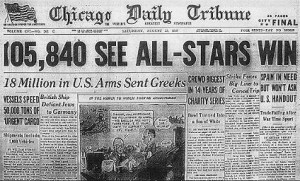
In 1947 the largest crowd ever to watch a professional football game in the United States saw the College All-Stars shutout the defending NFL champions.
Attendance was again over 100,000 in 1948 and remained above 88,000 until 1955.
As the NFL teams became stronger over time, the game became less competitive. After winning eight times between 1934 and 1958, the College All-Stars claimed only one win over the final 17 games in the series.
However, the fans still came out annually to watch some of the top college players make their initial professional appearance. Annual attendance stayed near 70,000 through 1970 and still eclipsed 50,000 in the final years of the game.
Each year an MVP was chosen from among the college players and a number of notable future NFL standouts received the honor including Charles Trippi, Elroy “Crazy Legs” Hirsch, John Brodie, Bobby Mitchell, John Hadl, Charley Taylor, Bubba Smith, Larry Csonka and Ray Guy.
Over time, the game became a no-win situation for the NFL teams. It was still seen as a “pride” game, which meant the NFL team needed to play to win. However, as salaries began to rise, teams became more concerned with risking injury to top players in a glorified exhibition against college players looking to impress future NFL employers.
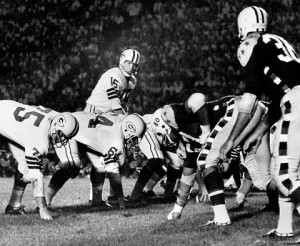
In 1963 Bart Starr and the Packers lost to an All-Star squad that featured future AFL and NFL stars Buck Buchanan, Bobby Bell, Ray Mansfield and Lee Roy Jordan.
The last win by the College All-Stars was in 1963 when an All-Star team coached by Otto Graham defeated Vince Lombardi’s Green Bay Packers 20-17. Though considered a fluke win, the College All-Star squad did include a number of future NFL and AFL stars including Buck Buchanan, Bobby Bell, Lee Roy Jordan, Ray Mansfield and Dave Robinson.
The loss by the NFL Champions proved to be a wake-up call, as the game was in doubt only twice over the final 12 contests.
A player’s strike in 1974 forced cancellation of the game and then it was discontinued for good following the 1976 contest. Ironically, the final game in the series was not memorable for the action, but instead because it included a heavy deluge of rain that forced cancellation with the Pittsburgh Steelers leading 24-0 late in the third quarter.
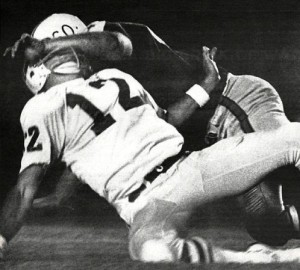
By the end, the risk of injury to stars such as Joe Namath became too great.
It was a disappointing way to end a series that for more than 40 years helped the NFL grow and prosper.
Considered one of the most successful fundraising campaigns in sports history, the annual game provided significant financial support to charities across the Chicago area for more than 40 years.
It also provided a showcase for future NFL stars and in many ways helped establish the legitimacy of the NFL. Ironically, it was once that legitimacy had been secured that the game became vulnerable and eventually lost its allure to the NFL.
While the game has not been played for more than 30 years, the memories are still alive and well. For more information about the illustrious history of the Chicago Charities College All-Star Game, go to http://www.mmbolding.com/BSR/Chicago_Charities_College_All-Star_Game.htm.
Information from the Chicago Charities College All-Star game web site was used in developing this story and pictures are from that site.
Hey Dean,
Congratulation for receiving another plug for your article and site on The Daily Fix. Liked your article; well written, very informative and timely. Do you remember watching any of those All-Star games in the early 1970's or replays later? I don't recall if we ever watched any of those games but we most likely did if you were interested in them. Mom doesn't have any specific recollection about those All-Star games but says she probably did watch some. Anyhow, really like your Web site, keep up the good work!
DAD
I vividly recall the 1967 game as it was a huge mismatch EXCEPT one player…Bubba Smith… was in GB's backfield all day destroying everyone who got in his way. ANY talk of top college players of all time must begin with that dude. When I hear talk of so called sure fire pro prospects I will only say I have seen ONE in my time…Bubba Smith.
Long time no see bloggers, and specially to see you support.
My uncle, Walter Maneikis, played in the first All Star game. Any idea where I can find any pictures, especially a team photo.
We may have a picture from University of Chicago. Our Walter was from Michigan, born 13 July 1908, professor of English, Chicago, and died in Florida 16 Oct 1998.
If this is the same relative, contact me by Email or 512-868-5533. Walter was married to our Charlotte in 1967, and our son, a coach, had a few items given by Walter to him back in the 1990's
any idea where a game film of the 1963 all star game can be gotten?
Charles, I'm David Brabham, brother of Dan Brabham. Dan played in that game & w/ Houston, Cinn. etc. I have been looking for this for some time. NFL says they do not have it and I can't get GB to return my call. Dan is now a member of the plan 88 team.Any help would be app. My cell # is 985-974-1950, Thanks!
David, I have not given up on the search yet. I wrote to Chicago Charities of the Chicago Tribune and await a answer. I tried ESPN Classics and no luck. I also tried NFL film with no luck. I may call you if any change of luck. Thanks.
The NFL is racist